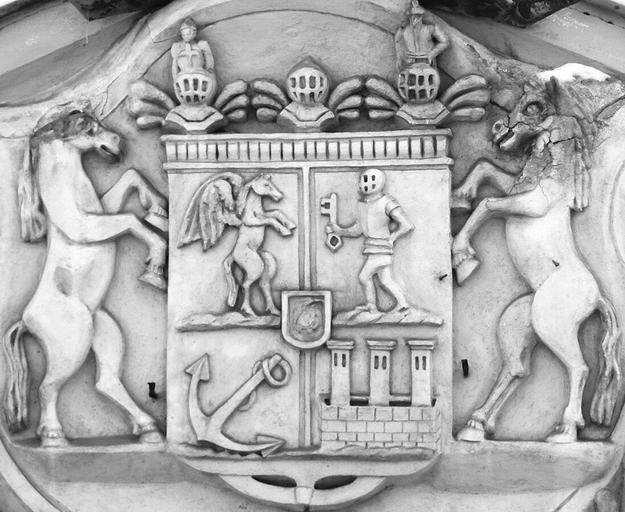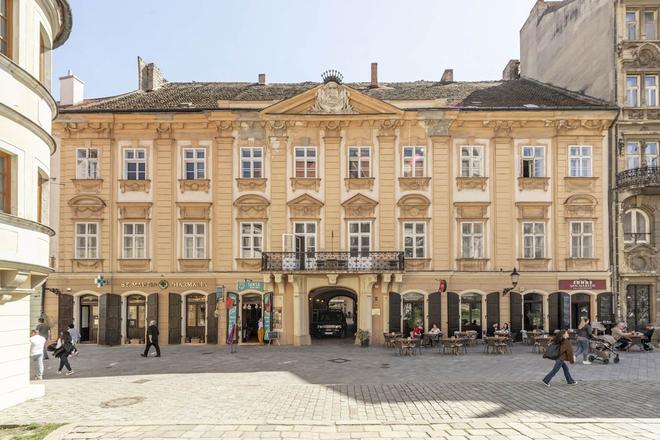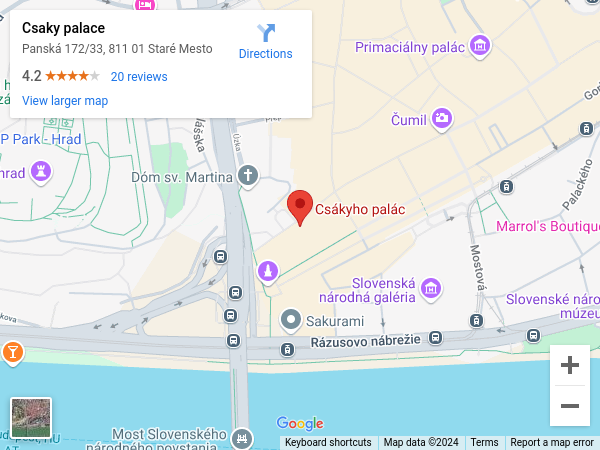Have you ever dreamt of owning a palace? One in the heart of Bratislava could be yours—if you happen to have a spare million or two.
Dating back to the late 18th century, Csáky Palace is a stunning example of Baroque and Classical architecture. It evokes Bratislava’s historic prominence as Pressburg (Pozsony), a key city during the Austro-Hungarian Empire and, for a time, the capital of the Kingdom of Hungary.
In the shadow of the monumental St. Martin’s Cathedral and straddling Panská Street and Hviezdoslav Square, the palace rises to five stories. There is additionally a basement and attic, which both have yet to be developed. The building was renovated extensively in the last decade, now having completely modern wiring as well as an updated sewerage system. It covers approximately 1,400 square metres, and includes an internal courtyard with 10 parking spaces. The building is occupied by several businesses. Among them are the San Marten cafe bar and Iasai, a popular Asian fusion restaurant.
The urban chateau sits in a very prominent location, just next to the iconic Salvator Apotheke building, a striking Neo-Renaissance pharmacy that recently reopened its doors to the public. Panská Street, or Lord’s Street, where the chateau sits, is so named because of the many noble families that built homes on it. The Palfy, Esterhazy, and Balaš families all had stately manors along Panská’s 360-metre thoroughfare.
The property listing notes that “the building is located in the immediate vicinity of the Danube embankment and the historic part of Bratislava with a selection of the best restaurants, cafes, and bars. Full civic amenities are within walking distance. There is excellent public transport accessibility and good traffic connections to the ring road.”
The seller has asked the price not to be disclosed, but representatives from the Svoboda & Williams reality firm, who are managing the sale, were able to confirm that the buyer should have “at least” €2,000,000 on hand. You might want to set aside an extra hundred thousand, as the five-storey building lacks an elevator.
A noble past
The palace is believed to have been commissioned by Juraj Csáky in 1775, a member of a Hungarian Noble family whose roots go back to Transylvania in the 1300s. The Csáky family had a great amount of influence in what is today Slovakia, particularly as the last owners of Spiš Castle. Their expansion into Slovakia occurred towards the end of the 16th century, when Štefan Csáky acquired the estates of Šariš, Spiš, and Turnian in 1603, as well as the Šariš castle manor in 1604. He became one of the wealthiest aristocrats in Slovakia. Initially active primarily in Spiš, the Csáky family later constructed two palaces in Bratislava and one in Košice (the Čáki-Dezőfi Palace).
There are several other buildings that belonged to the Csáky family in Bratislava. There is a second Csáky Palace on Štúr Street, and a large detached manor house in the Prievoz neighbourhood of Bratislava. The original historical building of what is now the Slovak National Theatre was also commissioned by them, following a design by Matthias Walch.
Matthias Walch, the architect who designed Csáky Palace, also designed several other prominent buildings in Bratislava, including the Great Evangelical Church on Panenská Street.
What's in a crest?
If you happen upon another Csáky building, be on the lookout for their distinctive, but grisly, coat of arms. It features the severed head of an Ottoman soldier, whose armies were at one time occupying much of the kingdom of Hungary.
The crest atop the building on it’s Panská Street side is not the crest of the Csáky family, however. It is that of Baron Josef von Dietrichberg. Also known as Josef Dietrich, he made his fortune supplying the Austrian army during the Napoleonic wars. Sometime in the early 19th century he came into ownership of Csáky Palace, placing his own seal at the top. That the palace did not remain in the hands of the Csákys perhaps points to it as an example of an early modern investment property.

Dietrich amassed a large fortune in his lifetime, with many properties all over the Austro-Hungarian empire, from Vienna to Tržič in Slovenia. He further expanded his wealth by purchasing ironworks and other business ventures. Due to his successes in business and services rendered during the Napoleonic wars, he was elevated to a Baron by Francis I, King of Hungary and final Holy Roman Emperor.
The 'mad' prince
After Dietrich, it is hard to work out the chain of custody of the building.
It appears that his estate was inherited by his grandson, Polish prince Józef Sułkowski. If Sułkowski ever held the deed for Csáky Palace is unknown, but by the 1870s, he had sold almost all of his grandfathers holdings to pursue a lavish lifestyle of travel with his personal theatre troupe and group of retainers. Things went for bad to worse from him when his wife, apparently under false pretenses, had him committed to an insane asylum for almost a decade. He managed to escape to Switzerland and have himself declared sane, and what remained of his wealth returned to him. He died in 1920.
Csáky Palace is a window into the regal and noble past of this country. Though it has been held variously by Hungarians, Austrians and Poles in the past, it is very much a piece of Bratislava's history. Any future buyer would become the steward of a piece of not just Slovak history, but of wider Central European history itself.



